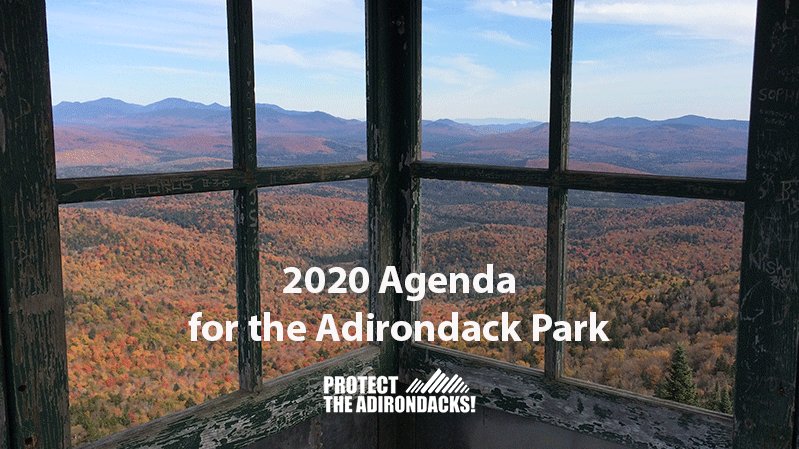Protect the Adirondacks has organized and is implementing a 2020 Agenda for the Adirondack Park that aims to expand protections of our environment while improving the quality of life and economy in local communities. This is a bold and ambitious agenda for the Adirondack Park that confronts head-on the major challenges facing the region. The agenda combines advocacy, public education, research, grassroots organizing, and legal action. We’re confident that in 2020, the first year of a new decade, this agenda will help to change and improve environmental protections for the public Forest Preserve, the wild spaces of the Adirondack Park, and the local communities.
There are many ways to volunteer with Protect the Adirondacks. Click here for membership information.
Defending Forever Wild in New York’s Highest Court: The Court of Appeals
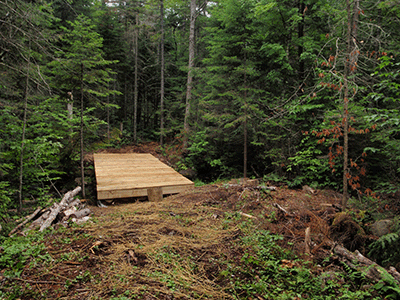 In July, PROTECT scored a major victory for the Forest Preserve–the people’s land–when the Appellate Division, Third Department, reversed a lower court to uphold protections against excessive tree cutting to build road-like snowmobile trails. Ruling in favor of Protect the Adirondacks, the Appellate Division found that state agencies had violated Article 14, the “forever wild” clause of the state Constitution. We’re now defending our victory against a state appeal to the Court of Appeals, New York’s highest court.
In July, PROTECT scored a major victory for the Forest Preserve–the people’s land–when the Appellate Division, Third Department, reversed a lower court to uphold protections against excessive tree cutting to build road-like snowmobile trails. Ruling in favor of Protect the Adirondacks, the Appellate Division found that state agencies had violated Article 14, the “forever wild” clause of the state Constitution. We’re now defending our victory against a state appeal to the Court of Appeals, New York’s highest court.
We launched this lawsuit in 2013 to challenge the construction of the first of what was projected to be hundreds of miles of new wide, road-like Class II community connector snowmobile trails in the public Forest Preserve. These trails represented the largest potential expansion of motor vehicle use in the history of the Forest Preserve. They are built with heavy machinery, graded flat for miles, and are fundamentally different from other types of trails on the Forest Preserve. We believed that this planned network of road-like trails violated the State Constitution because of the massive terrain alteration and tree cutting required. If these trails are allowed to be built out it will forever change the wild forest character of the parts of the Forest Preserve where they were approved. During the trial and litigation, Protect the Adirondacks counted, photographed, and documented the destruction of over 25,000 trees on the Forest Preserve.
We expect a decision in 2020. To read more about this lawsuit, see more articles here, here, here and here.
We Stopped Storage of Used Oil Tankers, Now Lets Build the 55-Mile-Long Hudson River Bike Trail
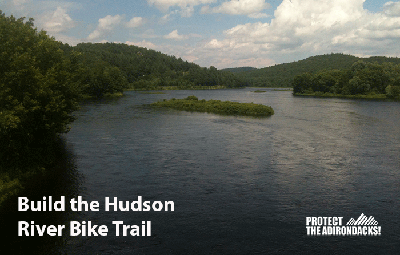 Protect the Adirondacks played a major role in efforts to beat back a terrible idea to store dirty oil tanker railcars in remote parts of the Adirondack Park, including long stretches of railroads that pass through the Forest Preserve. In 2017, over 100 oil tankers were brought to the Adirondacks for indefinite storage and they were removed in 2018.
Protect the Adirondacks played a major role in efforts to beat back a terrible idea to store dirty oil tanker railcars in remote parts of the Adirondack Park, including long stretches of railroads that pass through the Forest Preserve. In 2017, over 100 oil tankers were brought to the Adirondacks for indefinite storage and they were removed in 2018.
PROTECT is now working to organize plans to convert the 55-mile rail line that runs from North Creek to Saratoga Springs into a new Hudson River Bike Trail. This would be a tremendous asset for the region. From bases in Saratoga Springs or North Creek, bicyclists, runners and walkers, among other users, would enjoy a stunning trip with long unbroken sections at the north end. In the summer there are more than a dozen places to swim. In winter months, the trail would be available for cross-country skiing, snowmobiling and fat bike riding on snow.
Click here to read more about this tremendous opportunity to build a new public multi-use trail in the southern Adirondacks. Click here to read a letter making the case for conversion to Governor Cuomo.
It’s Time to Build a Great Public Lands Management Program for the High Peaks Wilderness
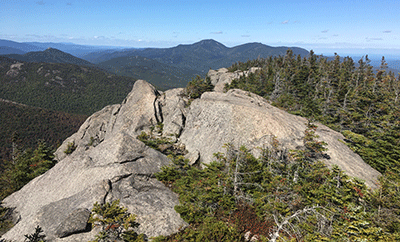 In 2020, PROTECT will continue to advocate to improve the management of the High Peaks, Hurricane and Giant Mountain Wilderness areas. These are the most popular Forest Preserve areas in the Adirondacks. These areas need a comprehensive management to address overuse and damage to hiking trails. It is imperative that the state invest in building sustainable trails, public education, Rangers and other personnel, and in new facilities such as a High Peaks Information Center, safe parking lots and new trailheads. This is a major effort in 2020.
In 2020, PROTECT will continue to advocate to improve the management of the High Peaks, Hurricane and Giant Mountain Wilderness areas. These are the most popular Forest Preserve areas in the Adirondacks. These areas need a comprehensive management to address overuse and damage to hiking trails. It is imperative that the state invest in building sustainable trails, public education, Rangers and other personnel, and in new facilities such as a High Peaks Information Center, safe parking lots and new trailheads. This is a major effort in 2020.
The 3-million-acre Forest Preserve in New York State is finest state lands system in the U.S., but it does not enjoy the finest management in the country. Now is the time to press for improvements in the management of the High Peaks and demand that the Cuomo Administration make adequate investments to build a network of sustainable trails, build proper facilities for parking and shuttles, invest in public education, adequately staff the High Peaks with planners, scientists, Rangers, and permanent trail crews, and effectively monitor and evaluate public use impacts.
Read more about PROTECT’s advocacy work to build a comprehensive management program for the High Peaks Wilderness here, here and here.
It’s Time to Amend the APA Act and Pass Conservation Development Legislation
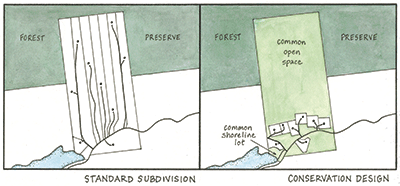 Protect the Adirondacks is pushing for an amendment to the Adirondack Park Agency (APA) Act to preserve the ecological integrity, wildlife and open space in the Adirondack Park in 2020. The bill, sponsored by Assembly Environmental Conservation Committee Chair Steven Englebright and Senate Environmental Conservation Committee Chair Todd Kaminsky would strengthen the Adirondack Park Land Use and Development Plan, originally adopted as part of the APA Act in 1973, by incorporating modern conservation design principles to curtail widely scattered exurban development, or “rural sprawl,” in the Adirondack Park. The APA Act has been largely unchanged since 1973.
Protect the Adirondacks is pushing for an amendment to the Adirondack Park Agency (APA) Act to preserve the ecological integrity, wildlife and open space in the Adirondack Park in 2020. The bill, sponsored by Assembly Environmental Conservation Committee Chair Steven Englebright and Senate Environmental Conservation Committee Chair Todd Kaminsky would strengthen the Adirondack Park Land Use and Development Plan, originally adopted as part of the APA Act in 1973, by incorporating modern conservation design principles to curtail widely scattered exurban development, or “rural sprawl,” in the Adirondack Park. The APA Act has been largely unchanged since 1973.
Conservation science now recognizes that the spatial pattern of development is fully as ecologically important as its density. Rural sprawl impairs ecosystem function, decreases biotic integrity, alters species behavior and composition, increases human-wildlife conflicts, and undermines the open space character of the Adirondack Park. The greatest threat to the forest products industry in New York is fragmentation of the forest resource into smaller lots and subdivisions because smaller lots will not be actively managed for commercial logging.
This bill would require that these factors be identified and considered for major, large-scale residential subdivisions in Low Intensity, Rural Use and Resource Management areas. The importance of this bill cannot be overstated. It would provide the APA with scientific tools necessary to review and evaluate proposals for large-scale residential development in the most vulnerable areas of the Adirondack Park. Click here for more information on the need for conservation design legislation.
Adirondack Park Boat Control Program Needed in 2020 to Stop Spread of Aquatic Invasive Species
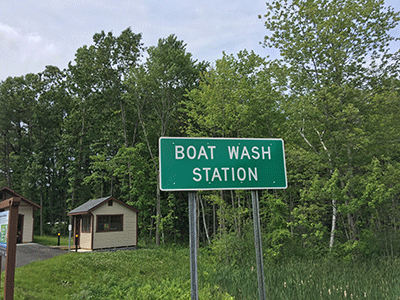 Protect the Adirondacks is advocating in 2020 for a mandatory boat inspection and decontamination program for the Adirondack Park. The Adirondacks is the last remaining area in New York State with a high number of lakes and ponds that are free of harmful aquatic invasive species.
Protect the Adirondacks is advocating in 2020 for a mandatory boat inspection and decontamination program for the Adirondack Park. The Adirondacks is the last remaining area in New York State with a high number of lakes and ponds that are free of harmful aquatic invasive species.
In 2014, PROTECT helped pass a new law in New York that made it illegal to transport aquatic invasive species. The law required that all boats must be clean, drained and dry before they can be launched in a waterbody in the state. This law expired in 2019 and was renewed for one year. Legislative leaders want to strengthen this law in 2020.
Despite the new transport law, lakes and ponds in the Adirondack Park have continued to see new infestations. In 2018, Fishhook waterflea was found in Lake Champlain. In 2016, Spiny waterflea was found in Indian Lake. Eurasian watermilfoil has been recently found in Eagle Lake outside of Ticonderoga and Square Pond. Variable leaf milfoil has been found in Franklin Falls Reservoir and Peck Lake.
In 2018, over 191,000 boaters across New York were surveyed by lake stewards who performed over 98,000 inspections. They found over 9.4% of boats had vegetation on them, and 3.7% (over 3,600 boats) carried aquatic invasive species. In 2019, over 205,000 boaters were surveyed and over 100,000 boats were inspected. Nearly 6% had vegetation on them, with 2.68% carrying aquatic invasive species (over 2,600 boats). Protect the Adirondacks will continue to press for a mandatory boat control law for the Adirondack Park.
In 2020, we need to build a comprehensive system across the Adirondacks for mandatory boat inspections, decontamination stations, and public education to protect Adirondack waters.
Expanding the Adirondack Lake Assessment Program
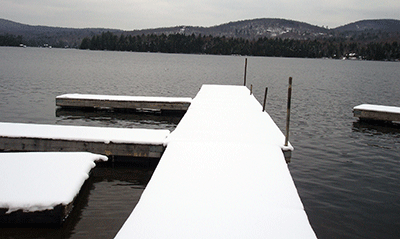 The Adirondack Lake Assessment Program (ALAP) was established in 1998 to provide water quality data to shoreowners and to develop a comprehensive, long-term database of water quality conditions in the Adirondack Park. 2020 marks the 23rd year of the program. ALAP is the largest volunteer-driven water quality monitoring program in the Adirondack Park, and is a partnership between Protect the Adirondacks and the Paul Smith’s College Adirondack Watershed Institute (AWI), along with more than 200 volunteers across the Adirondacks.
The Adirondack Lake Assessment Program (ALAP) was established in 1998 to provide water quality data to shoreowners and to develop a comprehensive, long-term database of water quality conditions in the Adirondack Park. 2020 marks the 23rd year of the program. ALAP is the largest volunteer-driven water quality monitoring program in the Adirondack Park, and is a partnership between Protect the Adirondacks and the Paul Smith’s College Adirondack Watershed Institute (AWI), along with more than 200 volunteers across the Adirondacks.
Over the past 23 years, ALAP has grown into one of the best long-term citizen science programs of its kind in New York and the eastern U.S.
Click here for more information about ALAP.
We’re Counting Building Permits for a Major Update of “Growth in the Adirondacks” Report to Assess Development Trends
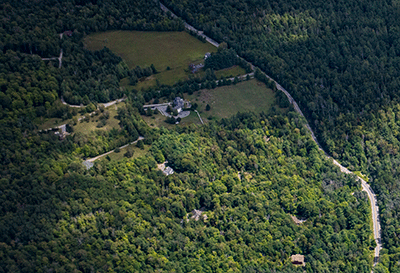 In 2001, PROTECT published the landmark report Growth in the Adirondack Park on building trends from 1990-1999. This report documented the amount of new development in the Adirondacks and examined the levels regulated by both local governments and the Adirondack Park Agency (APA). In 2020 we’re updating this report. The new report will examine growth rates, patterns and impacts from both 1973 forward, with the advent of regional private land use regulation in the Adirondack Park, as well as provide a detailed analysis of development impacts over 30 years from 1990-2019.
In 2001, PROTECT published the landmark report Growth in the Adirondack Park on building trends from 1990-1999. This report documented the amount of new development in the Adirondacks and examined the levels regulated by both local governments and the Adirondack Park Agency (APA). In 2020 we’re updating this report. The new report will examine growth rates, patterns and impacts from both 1973 forward, with the advent of regional private land use regulation in the Adirondack Park, as well as provide a detailed analysis of development impacts over 30 years from 1990-2019.
This report will compare development regulated by local governments and that regulated by state agencies. There has been zero work on tracking large-scale residential development in the Adirondacks since the 2001 report. This information is vital for land use planners, local governments, and all concerned about the future of the Adirondack Park.
Bringing the Realities of Adirondack Economic and Population Trends to Planning for the Future
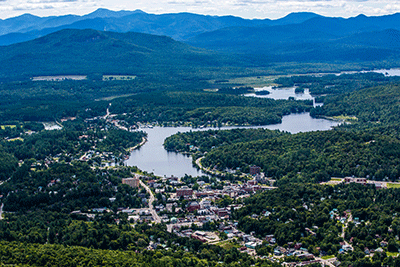 Protect the Adirondacks released The Adirondack Park and Rural America: Economic and Population Trends 1970-2010 in 2019. This report dispelled longstanding complaints that environmental protections have hampered population and economic growth in the Adirondacks by comparing the Adirondack experience with trends across Rural America. This report has been widely heralded and in 2020 we’ll be bringing this information to numerous public forums across the Park.
Protect the Adirondacks released The Adirondack Park and Rural America: Economic and Population Trends 1970-2010 in 2019. This report dispelled longstanding complaints that environmental protections have hampered population and economic growth in the Adirondacks by comparing the Adirondack experience with trends across Rural America. This report has been widely heralded and in 2020 we’ll be bringing this information to numerous public forums across the Park.
The data and analysis of this report make it clear that it is time to stop blaming whatever economic distress we find in the Adirondack Park on environmental protection, either in purchase of land for the Forest Preserve or conservation easement, or through limiting development on private land. We need to stop blaming the Park. The Adirondack Park and its residents and businesses are part of Rural America and subject to all the population and economic pressures experienced by similar regions throughout the United States. Adirondack economic and population trends are fully consistent with the experience of other rural areas across the U.S. What is special about the Adirondack Park is the world-class protected landscape of mountains, forests, lakes and rivers. The abundant, protected natural resources are a key asset and advantage for the region and sets the Adirondack Park apart from most other rural areas. Click here to read more about this landmark report.
In addition to giving public presentations on the Adirondack Park and Rural America report, PROTECT is working to organize an Adirondack Park and Rural America conference for the fall of 2021.
The Adirondack Park Agency Needs New Leadership and an Overhaul of the its Failing Board
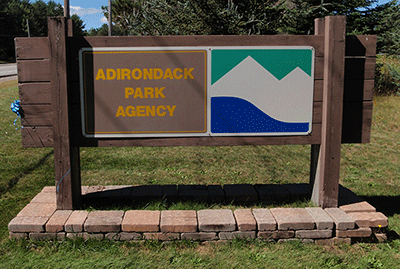 The Adirondack Park Agency (APA) needs reform and changes must start at the top with the APA Board. The APA Board is comprised of 11 members. Eight are nominated by the Governor and confirmed by the State Senate. Three represent state agencies, including the Department of Environmental Conservation, Department of State, and Empire State Development Corp. Of the eight board members confirmed by the State Senate, five must be permanent residents of the Adirondack Park and three must be permanent residents of areas outside the Adirondacks. No more than five Board members can be from one political party and the Governor selects the Chair. Board terms are 4 years long and the terms are set in statute with two terms expiring each year. APA Board members have regularly served in expired terms.
The Adirondack Park Agency (APA) needs reform and changes must start at the top with the APA Board. The APA Board is comprised of 11 members. Eight are nominated by the Governor and confirmed by the State Senate. Three represent state agencies, including the Department of Environmental Conservation, Department of State, and Empire State Development Corp. Of the eight board members confirmed by the State Senate, five must be permanent residents of the Adirondack Park and three must be permanent residents of areas outside the Adirondacks. No more than five Board members can be from one political party and the Governor selects the Chair. Board terms are 4 years long and the terms are set in statute with two terms expiring each year. APA Board members have regularly served in expired terms.
Currently, the APA Board has three vacancies. Among the five Board members from within the Adirondack Park, there are two vacancies. All but one APA Board member are serving in expired terms. Two current APA Board members have been on the Board since 2006.
Protect the Adirondacks is advocating in 2020 that members of the APA Board bring a range of professional experiences and undertake their duties with independence. It’s vital the APA Board include people with expertise in environmental law, science and regional planning. There is a role and voice for local government officials on the APA, but the Board should not be dominated by local government officials. It’s important that the Governor also submit nominations for a full slate to either replace Board members or nominate them for new terms. All members must be fully and publicly scrutinized.
Three Possible New Article 14 Amendments Could See First Passage in 2020
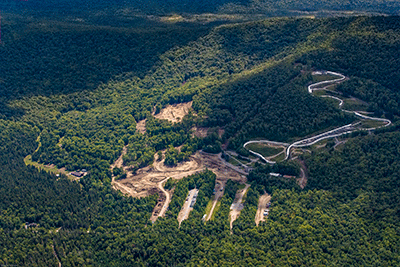 Protect the Adirondacks is monitoring and researching three potential constitutional amendments to Article 14, Section 1, the famed forever wild clause, of the NYS Constitution for 1st passage in 2020. The forever wild clause must be vigorously protected by New Yorkers. These include lands of the former Camp Gabriels state prison in the Town of Brighton in Franklin County, cleaning up longstanding violations of Forest Preserve law at the state Mt Van Hoevenberg Winter Sports Complex managed by the Olympic Regional Development Agency (ORDA), and for emergency communications facilities at Cathead Mountain that involve associated lands in the Silver Lakes Wilderness and Primitive areas.
Protect the Adirondacks is monitoring and researching three potential constitutional amendments to Article 14, Section 1, the famed forever wild clause, of the NYS Constitution for 1st passage in 2020. The forever wild clause must be vigorously protected by New Yorkers. These include lands of the former Camp Gabriels state prison in the Town of Brighton in Franklin County, cleaning up longstanding violations of Forest Preserve law at the state Mt Van Hoevenberg Winter Sports Complex managed by the Olympic Regional Development Agency (ORDA), and for emergency communications facilities at Cathead Mountain that involve associated lands in the Silver Lakes Wilderness and Primitive areas.
In all cases, PROTECT works to strengthen the Forest Preserve while resolving longstanding controversies, violations of Forest Preserve law or policy, or meet a key challenge for Adirondack communities or Adirondacks snack Park management that cannot be resolved in any other way.
Building Sustainable Hiking Trails in the Adirondack Park
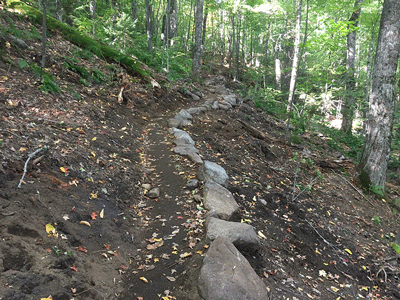 In 2020, Protect the Adirondacks will continue to advocate for bigger trail crews managed by the Department of Environmental Conservation (DEC) and will advocate for funding for long-term contracts with private and non-profit organization trail crews. The backlog for trail work in the High Peaks Wilderness at current rates will take more than 100 years to rebuild over 200 miles of trails in the High Peaks and build 100 miles of new trails for trailers peaks. Trail building in the High Peaks Wilderness should be part of a new comprehensive management program that integrates public education, facilities for parking and camping, and scientific monitoring of natural resources and public use impacts. In many ways the sustainable trail is the link that threads through and ties together effective wilderness management.
In 2020, Protect the Adirondacks will continue to advocate for bigger trail crews managed by the Department of Environmental Conservation (DEC) and will advocate for funding for long-term contracts with private and non-profit organization trail crews. The backlog for trail work in the High Peaks Wilderness at current rates will take more than 100 years to rebuild over 200 miles of trails in the High Peaks and build 100 miles of new trails for trailers peaks. Trail building in the High Peaks Wilderness should be part of a new comprehensive management program that integrates public education, facilities for parking and camping, and scientific monitoring of natural resources and public use impacts. In many ways the sustainable trail is the link that threads through and ties together effective wilderness management.
PROTECT is also working on a pioneering project to research and develop a new Hamilton County Trail Crew working win partnership with local governments there. The backlog of trail projects throughout Hamilton County is immense. This effort won a SmrtGrowth grant in the fall of 2019 to develop an inventory, priority list, and management program for a new Hamilton County Trail Crew that would work directly with the NYS DEC.
Bringing the Spirit and Law of the Climate Leadership and Community Protection Act to the Adirondack Park
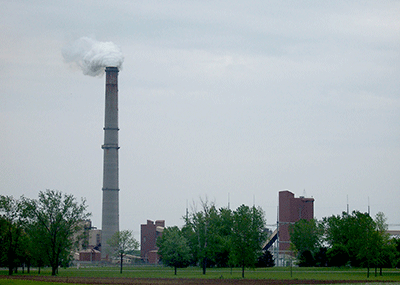 The ecological impacts of climate change are evident across the Adirondack Park. In 2019, New York State, lead by Assemblymember Steven Englebright and Senator Todd Kaminsky, passed the Climate Leadership and Community Protection Act. This legislation will begin to be implemented in 2020.
The ecological impacts of climate change are evident across the Adirondack Park. In 2019, New York State, lead by Assemblymember Steven Englebright and Senator Todd Kaminsky, passed the Climate Leadership and Community Protection Act. This legislation will begin to be implemented in 2020.
One aspect off this legislation is directives to state agencies that climate change mitigation and awareness are vital factors that must shape the work of state agencies. This directive has widespread impacts in the Adirondacks, which is in the midst of a boom of recreational housing, which are often second and third homes, and in motorized recreation utilizing low fuel efficient vehicles.
In 2020, Protect the Adirondacks plans to bring the letter and spirit of the Climate Leadership and Community Protection Act to the management and communities of the Adirondack Park.
New York Needs a Bigger Environmental Protection Fund
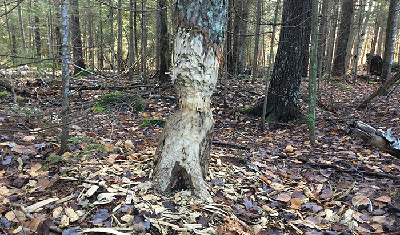 The EPF has been funded at $300 million for the last four years. This does not meet the environmental challenges facing New York State. In 2020, Protect the Adirondacks supports a larger EPF, increasing to $500 million over the next four years, by 2023, with a future goal of $1 billion. If New York is going to meet the immense environmental and climate change challenges ahead it needs greater resources.
The EPF has been funded at $300 million for the last four years. This does not meet the environmental challenges facing New York State. In 2020, Protect the Adirondacks supports a larger EPF, increasing to $500 million over the next four years, by 2023, with a future goal of $1 billion. If New York is going to meet the immense environmental and climate change challenges ahead it needs greater resources.
Protect the Adirondacks will work to ensure that the State Land Stewardship account funds at higher levels stewardship and maintenance of state lands, including the 3-million acre Forest Preserve, state forests, and wildlife refuges, among others. There has been a significant increase in the public’s interest in hiking, biking and visiting the Adirondacks, particularly in the High Peaks Wilderness area. Popular mountains, like Cascade Mountain, are seeing over 40,000 hikers a year, while others like Giant Mountain, Mount Marcy, and Algonquin Mountain are seeing over 30,000 hikers a year. The vast majority of trails in the High Peaks Wilderness need upgrades and repairs from damage from erosion, over-use, and a chronic lack of maintenance. The EPF needs to have a special line in the State Lands Stewardship category for the Forest Preserve or the High Peaks Wilderness for at least $10 million. The Land Protection category needs to be increased to meet the challenges of protecting important natural resources areas across New York. This fund should be at least $50 million.
PROTECT supports a new EPF account to fund environmental research in New York. It’s easier for academics and non-profits in New York to secure grants to do work in South America than it is to undertake studies in New York. The EPF needs a new category for research that focuses on the natural resources and the relationship between people and the environment in New York. This fund would need to create some form of review and administration function within the Department of Environmental Conservation and other agencies with Legislative review and approval. Environmental research should be funded at $5 million annually in the EPF. Good science makes good policy. New York State should invest in environmental research across the state to identify critical problems and to help fund solutions.
The Adirondack Park Needs More Forest Rangers
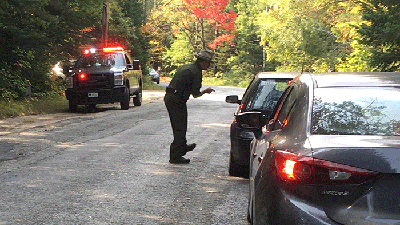 Protect the Adirondacks believes it is essential to increase the number of Forest Rangers and other personnel, such as assistant Rangers and backcountry stewards, to respond to the pressures of high public recreational use on the Forest Preserve. Ranger staffing for the entire state is currently around 135 positions. This needs to be expanded to 175 with a special focus on the High Peaks in the Adirondacks.
Protect the Adirondacks believes it is essential to increase the number of Forest Rangers and other personnel, such as assistant Rangers and backcountry stewards, to respond to the pressures of high public recreational use on the Forest Preserve. Ranger staffing for the entire state is currently around 135 positions. This needs to be expanded to 175 with a special focus on the High Peaks in the Adirondacks.
The Forest Rangers have primary responsibility for DEC’S care, custody and control of five million acres of State-owned land and conservation easements across New York, the vast majority of which is in the Adirondack Park. Today the average Forest Ranger is responsible for patrolling 53,752 acres. In 1970, it was 28,516 acres. There has been a major increase in public use, and the number of search and rescue missions has increased twofold.
Protection of Open Space in the Adirondack Park through Land Protection
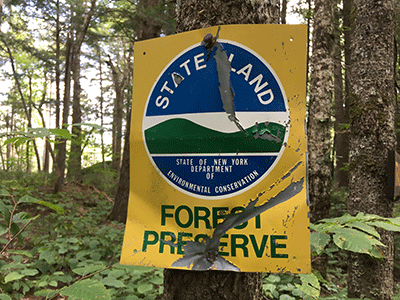 There are many possibilities and promising projects for land conservation in the Adirondacks, both in small projects that improve public access and new recreational opportunities to the Forest Preserve, protect sensitive habitats, or protect scenic vistas.
There are many possibilities and promising projects for land conservation in the Adirondacks, both in small projects that improve public access and new recreational opportunities to the Forest Preserve, protect sensitive habitats, or protect scenic vistas.
There are also immense opportunities for new conservation easement purchases, where the state purchases the development and recreation rights and the forest management rights remain with private landowners. Conservation easements are an important investment in the environment and the economy of the Adirondacks.
The great open space landscape of the Adirondack Park is what sets the region apart from anywhere else east of the Mississippi River. There is no other places with such a grand unbroken forested landscape dotted with small communities as exists in the Adirondack Park. This protected landscape, the crown jewel of New York’s heritage and commitment to environmental protection over the last century, defines the Adirondack Park experience for residents and visitors alike.
Advocacy for Community Development and Strategic Long-term Investments in Rural Adirondacks
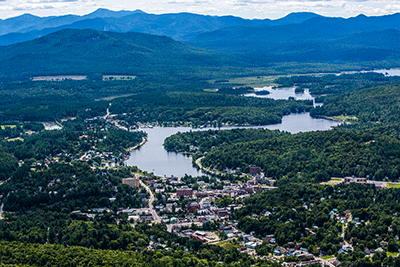 The Adirondack Park, like much of Rural America, is experiencing a stagnant economy and community vitality. In New York, over 1 million new jobs have been added since the Great Recession of 2007, but the overwhelming number of these jobs are downstate in New York in New York City, Long Island, and the three counties in the lower Hudson Valley around the Tappanzee Bridge. State funding for economic development in Upstate New York and the Adirondack Park uses support to rebuild or expand municipal water supply infrastructure, build salt sheds for local governments, and upgrade culverts and stormwater systems to meet new realities of climate change and restore ecological habitats, as economic development fundings. While it’s important to fund investments in these programs, it also shows that the State of New York, and local political leaders in Upstate New York and the Adirondacks, have no good ideas about economic development that will create jobs and improve their local economy. The Cuomo Administration is pleased to call any kind of state grant economic development, if when there is zero long-term employment associated with the state monies.
The Adirondack Park, like much of Rural America, is experiencing a stagnant economy and community vitality. In New York, over 1 million new jobs have been added since the Great Recession of 2007, but the overwhelming number of these jobs are downstate in New York in New York City, Long Island, and the three counties in the lower Hudson Valley around the Tappanzee Bridge. State funding for economic development in Upstate New York and the Adirondack Park uses support to rebuild or expand municipal water supply infrastructure, build salt sheds for local governments, and upgrade culverts and stormwater systems to meet new realities of climate change and restore ecological habitats, as economic development fundings. While it’s important to fund investments in these programs, it also shows that the State of New York, and local political leaders in Upstate New York and the Adirondacks, have no good ideas about economic development that will create jobs and improve their local economy. The Cuomo Administration is pleased to call any kind of state grant economic development, if when there is zero long-term employment associated with the state monies.
Protect the Adirondack is advocating for long-term, strategic economic development that puts in place the stepping stones for a vibrant local economy. Rural America is inextricably connected to the global economy, though powerless over it. Rural America is littered with discarded industrial facilities. Decisions on papermills, mines, grocery stores and pharmacies are not made locally, but are made from afar.
The future for Adirondack communities lies in building social amenities that are connected to our abundant and accessible natural resources. There is no new technology or app that will render our forests, lakes, and mountains obsolete. The Forest Preserve cannot be picked up and moved to China. The Forest Preserve can’t be closed and shuttered. The public amenities throughout our communities and public lands are the economic cornerstones for our region. Public funding should be made to projects that build or enhance community amenities or fund private business development that are tied to these amenities. In 2020, Protect the Adirondacks will work to try and focus community and economic development on building the ecological, social and cultural amenities of the Adirondack Park.
Advocating to Protect Adirondack Drinking Water and Lakes from Road Salt Pollution
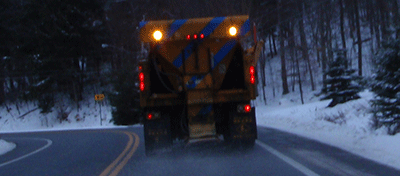 A major issue that is confronting many Adirondack communities is the degradation of lakes and ponds, in addition to wells for private residences, due to salt pollution from winter road maintenance practices. Research has found that while many major Adirondack lakes have stable or high water quality, they are also among the most highly polluted in the state from chloride and sodium. Recent studies by Paul Smith’s College Adirondack Watershed Institute (AWI) that looked at residential wells have found a high number that have become contaminated due to salt pollution.
A major issue that is confronting many Adirondack communities is the degradation of lakes and ponds, in addition to wells for private residences, due to salt pollution from winter road maintenance practices. Research has found that while many major Adirondack lakes have stable or high water quality, they are also among the most highly polluted in the state from chloride and sodium. Recent studies by Paul Smith’s College Adirondack Watershed Institute (AWI) that looked at residential wells have found a high number that have become contaminated due to salt pollution.
In 2020, Protect the Adirondacks will advocate for changes to highway management practices as well as new state laws to reduce or eliminate the use of road salt.
We Need More Motorless Waters in the Adirondack Park
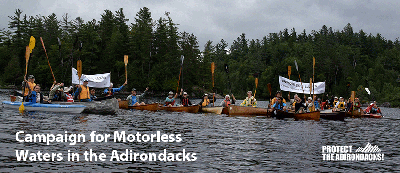 A report published by Protect the Adirondacks in 2013 The Myth of Quiet, Motor-free Waters in the Adirondack Park found that of the 100 largest lakes in the Adirondacks, from Lake Champlain to Beaver Lake (in Watson and Webb in western Adirondacks), 77 are open for all manner of motorized boating and floatplanes, 14 lakes are privately owned and provide no public access, and just 9 are motor-free. Boreas Ponds, which was recently purchased by the State of New York for addition to the Forest Preserve, and is number 95 among the Park’s biggest lakes at 338.9 acres, and was recently added to the motorless list.
A report published by Protect the Adirondacks in 2013 The Myth of Quiet, Motor-free Waters in the Adirondack Park found that of the 100 largest lakes in the Adirondacks, from Lake Champlain to Beaver Lake (in Watson and Webb in western Adirondacks), 77 are open for all manner of motorized boating and floatplanes, 14 lakes are privately owned and provide no public access, and just 9 are motor-free. Boreas Ponds, which was recently purchased by the State of New York for addition to the Forest Preserve, and is number 95 among the Park’s biggest lakes at 338.9 acres, and was recently added to the motorless list.
Of the nine motor-free lakes among the Park’s top 100, just six are relatively easy to access and motor-free. Just 17 of the biggest 200 lakes are easily accessible and motor-free. In the Adirondack Park’s Forest Preserve, lands designated Wild Forest include over 100,000 more acres than lands designated Wilderness. Wilderness lands should be equal to Wild Forest. For all the reasons detailed in this report there needs to be many more opportunities for easily accessible motor-free waters in the Adirondacks for people to enjoy.
Several dozen canoes and kayaks can be in simultaneous use on a motor-free lake or pond, such as Lake Lila or Round Lake, and the experience remains one of tranquility. Put several dozen motorboats on one such lake and the experience is dominated by the buzz of engines, surge of boat waves, and smell of gasoline.
The demand is high for motor-free experiences, but the supply is low. This needs to change. The public deserves greater opportunities for motor-free waters across the Adirondack Park. In 2020, Protect the Adirondacks will continue its campaign for more motionless waters in the Adirondack Park.
Reforms and Changes Needed to NYS Wildlife Laws
 Protect the Adirondacks remains opposed to the 6-month open season for coyote hunting and to the 4-month-long season for bobcat hunting. The coyotes season is an open slaughter, something that we’d expect from states like Idaho and Alaska, not New York. The “control methods” for coyotes such as unlimited killing with no limits on daily of seasonal hunting, along with a 6-month-long season, are counter productive because when their numbers are threatened coyotes reproduce in even larger numbers. The bobcat season is too long and the extension into deep winter months like February further stress these animals in their most challenging times of the years. In addition to pressing reforms for coyote and bobcat hunting, Protect the Adirondacks will continue to oppose cable snare trapping and other cruel methods.
Protect the Adirondacks remains opposed to the 6-month open season for coyote hunting and to the 4-month-long season for bobcat hunting. The coyotes season is an open slaughter, something that we’d expect from states like Idaho and Alaska, not New York. The “control methods” for coyotes such as unlimited killing with no limits on daily of seasonal hunting, along with a 6-month-long season, are counter productive because when their numbers are threatened coyotes reproduce in even larger numbers. The bobcat season is too long and the extension into deep winter months like February further stress these animals in their most challenging times of the years. In addition to pressing reforms for coyote and bobcat hunting, Protect the Adirondacks will continue to oppose cable snare trapping and other cruel methods.
Protect the Adirondacks will also press in 2020 for research into the viability of wolf and cougar reintroduction to the Adirondack Park and New York. There has never been a serious look at the viability of reintroduction of these long-extirpated species and this research is badly needed.
There are many ways to volunteer with Protect the Adirondacks. Click here for membership information.

